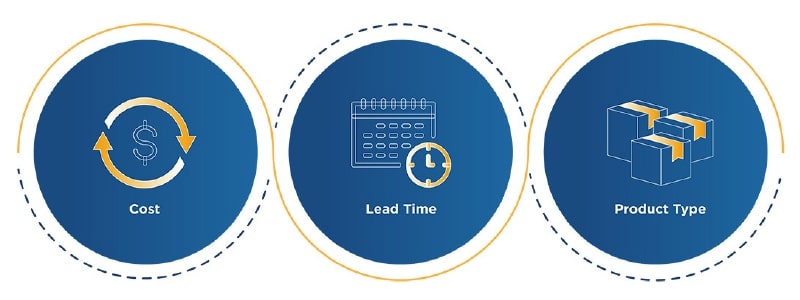
2022’s capacity crunch is in the rearview mirror, but it’s never too early to plan for the next up cycle. Here’s how to choose your optimal ground transportation mode.

2022’s capacity crunch is in the rearview mirror, but it’s never too early to plan for the next up cycle. Here’s how to choose your optimal ground transportation mode.
Helen Mann | Inbound Logistics
February 2023
Most supply chain executives probably aren’t eager to relive the 2021 freight cycle any time soon. Between pandemic-induced disruptions, equipment and labor shortages, and an e-commerce boom, it was not an easy time to obtain transportation capacity. Now that the market has cooled, shippers have the chance to prepare for the next up cycle. This involves selecting domestic transportation modes.
There are several factors to consider when choosing between over-the-road and intermodal. Does the rise in online shopping mean that companies should fortify their trucking strategy? Or would intermodal help offset increasing last-mile expenditures? How do fuel prices figure into transportation decisions? What about balancing costs and service levels?
Shippers must evaluate their individual needs and priorities to determine an optimal strategy.
The answer depends on a variety of criteria that differs from one scenario to the next. Shippers must evaluate their individual needs and priorities to determine an optimal strategy.
Here are five factors to weigh when deciding between over-the-road and intermodal.
Typically, intermodal is the go-to option for cost savings, while over-the-road trucking tends to prevail when there’s a time constraint. Products moved on a truck often spend less time at rest and have fewer handling points, which translates into shorter lead times.
“Our shippers typically select over-the-road transportation based on transit time and consistency,” says Frank Hurst, president of Roadrunner, an LTL carrier headquartered in Downers Grove, Illinois. “They need to know how long it will take to get from point A to point B so they can plan their operations accordingly.”
When delivery speed is less of a concern, intermodal offers robust capacity with a smaller price tag.
When delivery speed is less of a concern, intermodal offers robust capacity with a smaller price tag.Over-the-road pricing is calculated, in part, based on length of haul, while rail utilizes flat rates. Freight that’s traveling at least 700 miles is a good candidate to convert to intermodal.
“Typically, intermodal will be $300 to $500 cheaper door-to-door than over-the-road,” says Luke Simendinger, vice president of intermodal services at Chicago-based 3PL and freight brokerage, Coyote Logistics. “Instead of one truck moving across North America, you might get 200 loads on a train. There’s significant savings, not only in transportation costs, but in accessorials, such as fuel surcharges.”
The spread between over-the-road and intermodal costs shrank as the trucking market cooled in 2022. Trucking spot rates fell by 31.8% in the third quarter, according to Coyote Logistics’ Q4 Truckload Market Forecast for 2022. And national van rates averaged $2.39 per mile in mid-November, seven cents below the October average, according to DAT’s Trendlines Report.
Declining rates could convert some freight from intermodal to over-the-road transportation.
“Over-the-road costs are so low now that shippers might be able to get a higher service level at a price that’s nearly competitive with intermodal,” notes Christopher Thornycroft, executive vice president of procurement at 3PL Redwood Logistics.
With its high capacity and standardized transit schedules, rail transportation is best for shippers who move consistent large quantities of freight.
“The decision tree a shipper uses differs for a rateable high-volume lane that moves every day of the year versus a single shipment or single pallet quantity,” says Andrew Lynch, group vice president of domestic marketing and sales at Norfolk Southern, a Class 1 railroad based in Atlanta. “Those are two drastically different freight decisions.”
One consideration is economic order quantity. Every organization has an optimal order size. This allows them to meet demand without paying to hold excess inventory.
One consideration is economic order quantity. Every organization has an optimal order size. This allows them to meet demand without paying to hold excess inventory.Rail is suited to move large quantities of freight, but that doesn’t mean customers are prepared to handle those volumes. “You’ve got to consider your customer’s behavior,” notes Ken Sherman, president of IntelliTrans, a technology-enabled transportation management service company headquartered in Atlanta. “Do they want the whole railcar to show up at once, or will they need one-fourth of a railcar to show up one week apart?”
On the other hand, over-the-road shipping is a better fit for spot freight.
“Intermodal typically works best when there is consistency in order to keep containers moving,” says Jake Schnell, vice president of sales operations at RXO, an asset-light transportation provider and freight brokerage based in Charlotte, North Carolina. “When volume is sporadic or it is a short-term project, over-the-road can provide more flexibility as volumes ebb and flow.”
The pandemic highlighted the need to adapt to rapidly changing circumstances. Shippers had to constantly be prepared to work around unanticipated chokepoints. This need for resilience applies whether operating in pandemic conditions, or dealing with another unforeseen event.
Take weather conditions, for example. “A major tropical storm hit Florida and Georgia recently,” says Schnell. “How will that impact ports in that region?” .
When a storm hits, trucking offers the possibility to take alternate routes. For example, by using RXO Connect, a visibility tool that provides insights into weather or traffic, carriers can shift to a corridor with fewer disruptions.
“We might see something happening on a particular corridor and decide to reroute a driver so we don’t miss a delivery,” Schnell explains. “That applies whether there’s a tropical storm or a product launch. Obviously if there’s a blizzard, it doesn’t matter if freight is traveling by rail or highway. There will still be disruptions. However, the flexibility to take alternate routes doesn’t happen with rail.”
Not every origin or destination point is located in the vicinity of a rail yard. Intermodal widens access to rail by including a drayage service to or from an origin or destination point. But the additional moves add a layer of complexity.
“You typically have ramps plus a dray move in this process,” says Sherman. “First, a truck picks up the container or trailer at the origin. The container is then driven to an origin ramp, where it’s brought into a rail yard. Next, the container gets put on a well car.”
That process happens in reverse once a container reaches its destination. “Rail service will get as close as it can to the destination point, but then the container must be deramped, and taken away by truck for the final delivery,” Sherman explains.
“Over-the-road, in contrast, is the easy button,” he adds. “It has an origin and destination in just about any market, and there are thousands of carriers across North America.”
Intermodal’s additional moves can be further complicated by a lack of available equipment. “Chassis availability is important to understand when using intermodal,” says LeAnne Coulter, vice president of freight management at Penske Logistics, a logistics services provider based in Reading, Pennsylvania. “You don’t want to be in a situation where you’ve run out of free days at a port and you don’t know how you will get that container unloaded and returned.”
To mitigate some of these complications, companies might enlist the help of an intermodal marketing company, or IMC. “The process looks almost as easy from the shipper perspective,” Sherman says. “The IMC picks up the freight, just like in truckload, but it goes to a ramp. All the shipper sees is a different rate and transit time.”

Most commodities that could be shipped via intermodal transportation could also move on a truck. But certain products have specific requirements that an organization needs to take into account.
One is equipment availability. “What kind of equipment does the product require, and what’s the best way to get it?” asks Anne Reinke, president and CEO of the Transportation Intermediaries Association, a professional association of third-party logistics providers. “Is the commodity over-dimensional? Does it require special handling?”
Refrigeration is one example. If you transport strawberries, you need to work with specialized reefer equipment that is held at a precise temperature.
Refrigeration is one example. If you transport strawberries, you need to work with specialized reefer equipment that is held at a precise temperature.“Refrigerated moves generally require additional technology, such as sensors that can detect any changes in the temperature of the container or reefer van,” Reinke adds.
It’s equally important to understand how regional activity impacts freight capacity. For example, carriers might gravitate toward California during produce season, or haul large orders of bottled water from the Northeast during the summer months.
“Looking at capacity on a national level doesn’t tell the whole story,” says Reinke. “You miss a lot of opportunities if you don’t spend time planning in regional areas.”
There are many factors to consider in mode selection, and the tumult of the past three years has not made the decision any easier. The good news is that companies that plan ahead and employ an agile mindset will be prepared for the next freight cycle, whatever form it comes in.
When loads are too small to fill a 53-foot trailer, a shipper may choose to haul them using less-than-truckload, or LTL, service instead. In this method of transportation, multiple shipments are loaded onto a single truck and transported across a multi-stop route.
A benefit of LTL is that instead of paying for an entire truck, shippers are charged only for the space they use.
“There are generally weight or cube requirements from an LTL standpoint,” explains Scott Schara, chief commercial officer at BlueGrace Logistics
“There are generally weight or cube requirements from an LTL standpoint,” explains Scott Schara, chief commercial officer at BlueGrace Logistics, a third-party logistics provider headquartered in Tampa, Florida. “Up until roughly 10,000 pounds, there’s a cost benefit to shipping LTL versus truckload. One pallet is much more cost effective to ship LTL than it is to ship truckload because you’re paying for the entire truck.”
Transit time is an important consideration in LTL. Shippers must be cognizant of their schedule requirements, as freight typically won’t move along a direct route.
“LTL freight traditionally goes through breakbulk,” Schara says. “It might get loaded from Los Angeles to Dallas, get broken down, travel from Dallas to Atlanta, get broken down once more, and then shipped out again. The nuance of lead time comes into play.”
That process means loads are touched more frequently than full truckload freight—a service that can come with accessorial charges.
“If there’s a driver touch that wasn’t specified at the time of the quote, if there’s an inside delivery, if there is a lift gate required, there can be accessorial costs,” says Christopher Thornycroft, executive vice president of procurement at Redwood Logistics.
“Eventually those charges add up,” he says. “What may start as a quote for $325 could go up to $600 one week later. You can lose the sense of visibility and control that comes with over-the-road truckload.”
Get expert logistics insights delivered straight to your inbox
"*" indicates required fields